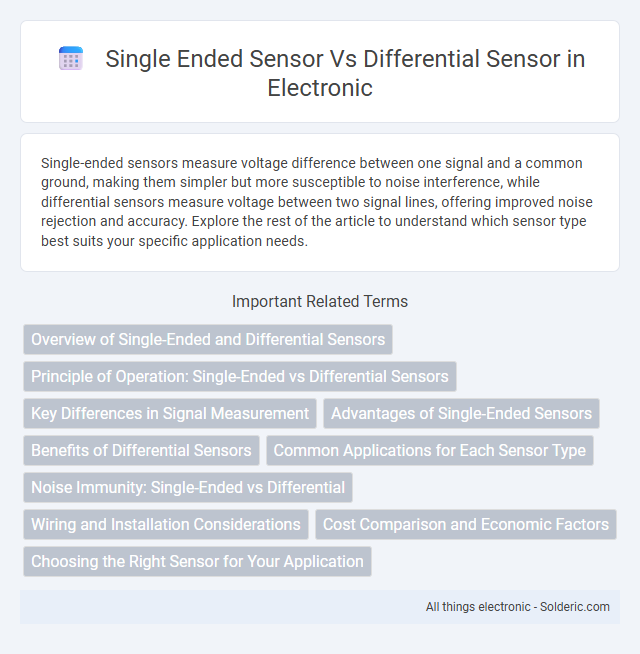Single-ended sensors measure voltage difference between one signal and a common ground, making them simpler but more susceptible to noise interference, while differential sensors measure voltage between two signal lines, offering improved noise rejection and accuracy. Explore the rest of the article to understand which sensor type best suits your specific application needs.
Comparison Table
| Feature | Single Ended Sensor | Differential Sensor |
|---|---|---|
| Signal Reference | Measures voltage relative to ground | Measures voltage difference between two inputs |
| Noise Immunity | Lower, more susceptible to common-mode noise | Higher, rejects common-mode noise effectively |
| Accuracy | Moderate | High accuracy due to noise rejection |
| Application | Simple, low-cost sensing (e.g., temperature, light) | Precision measurements in noisy environments (e.g., strain gauges, sensors requiring balanced inputs) |
| Circuit Complexity | Simple design | More complex, requires differential amplifiers |
| Cost | Lower cost | Higher cost due to additional components |
Overview of Single-Ended and Differential Sensors
Single-ended sensors measure voltage relative to a common ground, making them simpler and more cost-effective but more susceptible to noise and interference. Differential sensors detect the voltage difference between two input terminals, providing higher accuracy and noise immunity, especially in electrically noisy environments. Your choice depends on the application's precision requirements and the level of ambient electrical noise.
Principle of Operation: Single-Ended vs Differential Sensors
Single-ended sensors measure the voltage or signal relative to a common ground, making them susceptible to noise and interference from external sources. Differential sensors operate by measuring the difference between two input signals, effectively canceling out common-mode noise and improving signal integrity. This principle allows differential sensors to provide more accurate and stable readings in electrically noisy environments compared to single-ended sensors.
Key Differences in Signal Measurement
Single-ended sensors measure the voltage of a signal relative to a common ground, making them susceptible to noise and ground loops, which can degrade signal integrity. Differential sensors compare the voltage difference between two input signals, effectively rejecting common-mode noise and improving measurement accuracy in electrically noisy environments. You can achieve more precise and stable data acquisition by selecting differential sensors for applications requiring high noise immunity.
Advantages of Single-Ended Sensors
Single-ended sensors offer simplicity in design and reduced wiring complexity, making them cost-effective and easier to integrate into existing systems. They require fewer components and are effective in applications where signal interference and noise are minimal. Your choice of a single-ended sensor can lead to faster implementation and lower maintenance requirements in controlled environments.
Benefits of Differential Sensors
Differential sensors offer improved noise immunity by measuring the voltage difference between two input signals, reducing common-mode interference that often affects single-ended sensors. They provide higher accuracy and better signal integrity in electrically noisy environments, making them ideal for precision applications such as industrial automation and medical instrumentation. Enhanced sensitivity and greater resistance to ground loop errors further contribute to the reliability and performance advantages of differential sensor configurations.
Common Applications for Each Sensor Type
Single-ended sensors are commonly used in applications requiring straightforward signal measurements, such as temperature sensing, light detection, and simple pressure monitoring where noise interference is minimal. Differential sensors excel in environments with high electrical noise or long cable runs, making them ideal for industrial automation, medical instrumentation, and audio applications that demand precise, noise-free signal detection. Your choice between the two should consider the signal noise environment and the need for accuracy in the measurement.
Noise Immunity: Single-Ended vs Differential
Differential sensors provide superior noise immunity compared to single-ended sensors by measuring the voltage difference between two inputs, effectively canceling out common-mode noise and interference. Single-ended sensors, measuring voltage relative to a common ground, are more susceptible to noise from electromagnetic interference and ground loops. Choosing a differential sensor for your application ensures more accurate signal acquisition in electrically noisy environments.
Wiring and Installation Considerations
Single-ended sensors require a single signal wire and a common ground, making wiring simpler but more susceptible to noise interference, especially over long distances. Differential sensors use two signal wires carrying opposite signals, which helps cancel out electromagnetic noise, providing more reliable data transmission in electrically noisy environments. When planning your installation, consider that differential sensor wiring demands careful cable pairing and shielding, increasing complexity but enhancing signal integrity.
Cost Comparison and Economic Factors
Single-ended sensors typically incur lower initial costs due to simpler design and fewer components, making them more budget-friendly for basic applications. Differential sensors, while more expensive upfront, offer enhanced noise immunity and accuracy that reduce long-term maintenance and error-related costs, proving economically advantageous in industrial and critical measurement settings. Your choice should consider both immediate budget constraints and potential savings from improved performance and reliability over time.
Choosing the Right Sensor for Your Application
Selecting between a single-ended sensor and a differential sensor depends on your application's noise environment and signal accuracy requirements. Single-ended sensors measure voltage relative to a common ground, making them suitable for low-noise settings and simpler circuitry. Differential sensors capture the voltage difference between two inputs, offering superior noise rejection and accuracy in demanding or electrically noisy environments.
Single ended sensor vs differential sensor Infographic

 solderic.com
solderic.com